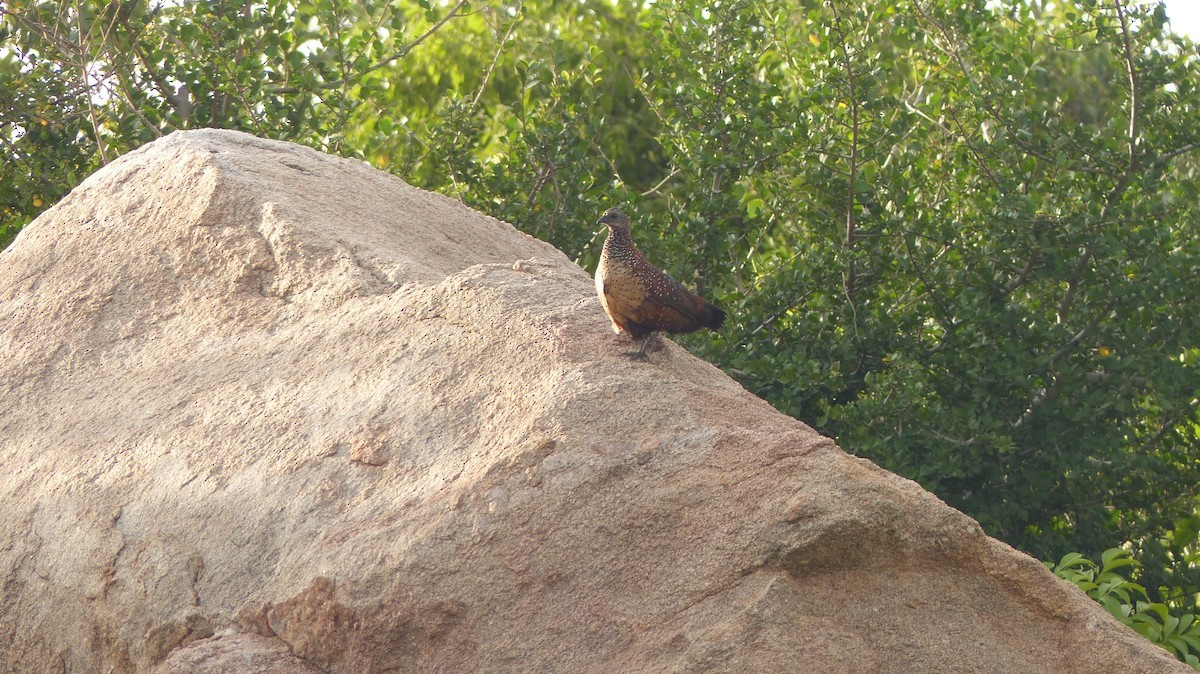Painted Spurfowl
A species of Spurfowl Scientific name : Galloperdix lunulata Genus : Spurfowl
Painted Spurfowl, A species of Spurfowl
Botanical name: Galloperdix lunulata
Genus: Spurfowl
Content
Description General Info
 Photo By Ashwin Viswanathan
Photo By Ashwin Viswanathan Description
This spurfowl is distinctive in having no bare facial skin as in the red spurfowl. The male has a black tail and ochre underparts that contrast with the darker upperparts. The plumage of the upper parts and the feathers have white spots edged with black. The head and neck of the male are black with a green sheen and finely spotted in white while the mantle, rump and wing coverts are chestnut. The female is much duller with a rufous brow and ear coverts. The throat is pale and spotted as in the male but the female lacks white spotting on the body. The bill and legs are dark grey, with two to four tarsal spurs on the male. Females can also have one or two spurs. The tail is sometimes carried upright. 
Size
34 cm
Nest Placement
Ground
Feeding Habits
Painted Spurfowl consumes a varied diet including seeds, tubers, drupes, and berries from plants like Zizyphus, Lantana, and Ficus. They also eat small land molluscs and insects, with a preference for termites. Typically found foraging in pairs.
Habitat
The painted Spurfowl typically resides in thorn scrub environments dominated by vegetation such as Anogeissus, Bridelia, Acacia, and Mimosa, as well as bamboo jungles. These birds are often found in arid regions with rocky hills and may also be seen in proximity to water sources. They have a preference for drier conditions compared to related species.
Dite type
Omnivorous
General Info
Feeding Habits
Bird food type
Behavior
The painted spurfowlis found in pairs or small family parties of up to 6 individuals and tends to stay in the undergrowth, rarely taking to flight. The call is a loud repeated series of chuguk calls. They feed on berries (including Ziziphus oenoplia and Lantana camara) as well as insects and flowers (Madhuca longifolia); and visit waterholes in the early morning. The breeding season is January to June (mainly February, but chicks have been seen in August, after the rains, in parts of Rajasthan). Courtship involves the male offering food held in the bill to the hen. Spurfowl are as a genus thought to be monogamous. The nest is a scrape in the ground lined with leaves often located below a boulder. The clutch is three to four, rarely five, pale creamy eggs. Only the female incubates, but both parents take care of the chicks. They will use distraction displays to lead predators away from the chicks. 
Distribution Area
The painted spurfowl is found in some parts of the Aravalli ranges in Rajasthan, the hills of central India (Pachmarhi) and the rocky hills and dry forest areas of southern India. They have also been recorded in the Nallamalai region in the Andhra Pradesh eastern Ghats. The habitat is drier than that of the red spurfowl. In parts of southern India, they are found in rocky hills with scrub slopes, a habitat that is also used by the yellow-throated bulbul. 

 Photo By Ashwin Viswanathan
Photo By Ashwin Viswanathan